Troubleshooting your Mission:
Dealing with problem behaviors

Dealing with problem behaviors

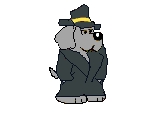
|
As you progress through your mission, you may encounter difficulties. This section will hopefully help you find solutions.
|

|
Discipline Methods: In the section on training tips we touched on “start and stop behaviors.” A start behavior would be when you are trying to get the Weimaraner to do something such as sit. A stop behavior is when you are trying to stop him from doing a negative behavior such as nipping. For start behaviors we strongly urge you to use positive reinforcement not punishment. For stop behaviors punishment is appropriate. By punishment, we are referring to using your voice or a shake can to scare the puppy away from what he was doing. A shake can is a metal can with coins or rock (or anything else that will make a loud noise) in it.
|
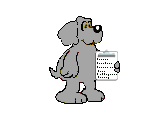
|
Before you begin…go over your checklist.
|

|
Consistency: Are you being consistent? Do you let your puppy jump on you in play, and then punish him for jumping when you are in your nice clothes? Training takes effort. You will need the energy to reinforce positive behavior and to and punish negative behavior every time.
|

|
Voice Tone: Do you use a strong and firm enough voice when disciplining to scare him away from what he was doing? Do you use a soft kind voice when praising?
|

|
Reinforcing appropriate behaviors: Are you reinforcing the right behaviors and not unintentionally reinforcing the wrong behaviors? For example, when your dog growls, barks or whines, if you calmly tell him… “That’s ok”…then you are reinforcing that behavior…and it will likely increase! |

|
Finding the right buttons: Have you found your dogs buttons? Have you discovered what he will work for?
|

|
Time: Are you spending enough playtime with your dog so he is not bored or craving attention? Are you exercising him adequately so he does not have a lot of pent up energy?
|

|
Supervision: Do you adequately supervise your dog? A bored Weimaraner loose and unsupervised in the house is almost certain disaster. This is especially true during the house-training phase. Try never to let him mess in the house without you catching him doing it.
|

|
Cleaning up: Do you keep temping, but off limit chewables out of the dogs reach? If you don’t want him to chew on your shoes, keep them picked up.
If you are doing everything correctly on the checklist and are still having problems…read on. |

|
Potty Training: Ok…if you puppy is over 5 months, you have tried everything we talked about in training tips, and he still goes on the floor on a regular basis; you may need to get him checked by a vet for a physical problem. If all is clear then reevaluate your checklist again. Make sure you are using a strong enough sound to scare him when you catch him in the act. If your voice is not enough, use a shake can or a loud horn. In addition, make sure you are taking him out and feeding him at regular intervals. Make sure you are watching him close, and have learned his “potty behavior” (many dogs will sniff the ground, turn in circles, or have a certain look on their face before they go potty). When you notice his “potty behavior” take him out immediately. Start taking him out for long walks so you can catch him pottying outside and praise him more often. You may need to teach him to tell you when he needs to go out. Pick a signal (such as sitting by the door, a bark, ringing a bell…) and have him perform this signal every time before you go outside.
|
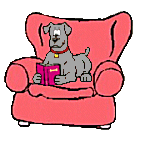
|
Climbing on furniture: Consistency is crucial when trying to correct this problem. You cannot let the Weimaraner up on the couch to cuddle with you one day, and then punish him for getting on the couch another day. If you want to cuddle with him…get on the floor with him. Then when he gets on the couch you can use a shake can or loud no…to get him off. Some people have recommended putting mouse traps on the couch…when the Weimaraner tries to climb up, the movement will cause the traps to shut, scaring the Weimaraner. We have never actually tried this method…so we cannot say how well it would work. There are also mats you can buy at pet stores or through pet catalogues that you put on the furniture. When the dog tries to climb on the mat will give him a mild unpleasant shock. Again we have never tried this…so we cannot say how well it works.
|
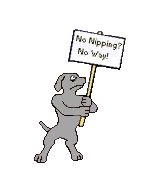
|
Nipping: This is an extremely critical problem area that needs immediate correction. Puppies mainly nip when they are over excited…which if allowed can lead to major problems when they are adults. Never let your puppy mouth you even in play. If the puppy does put his mouth on you, give a high pitched loud “eeek.” This is similar to the sound their littermate gave to warn them to stop a behavior. The puppies should immediately let go.
Another time puppies may nip is when they are chasing you. Chase with the puppy seems to be a particularly fun game for children…yet can lead to trouble. Therefore we advise you to discourage this type of play. When the puppy starts to chase…whoever is being chased should stop…turn around and say “NO”. |
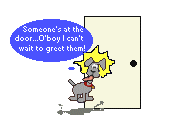
|
Jumping on people: We have yet to meet a Weimaraner that did not have this problem at one time or another. Weimaraners love their people, and like to display their love by jumping on their people after a period of absence. Unfortunately most people do not appreciate this particular type of affection. If you are one of these people simply stick your knee out every time the Weimaraner tries to jump on you. The force of the Weimaraners momentum should knock him over. Be careful not to actually kick your dog as you do not want to hurt him, but to just knock him away. After discovering that jumping on people is not the best way to show affection…most Weimaraners stop this behavior. For particularly persistent Weimaraners, you may need to add a strong “no” when you stick your knee out.
An alternative to this method is to have you dog perform a behavior that is incompatible with jumping when he approaches you. For example, whenever your dog approaches you, you can give the “sit” command, and praise him when he sits. It is hard for a dog to jump in the sitting position! |

|
Excessive barking: First, determine the source of the barking…is he barking out of boredom or anxiety? Does he bark for attention or does he bark because he feels like he is protecting the house? The source can often determine the solution. If he is anxious, you may need to work with him to reduce his level of anxiety. Build his confidence by spending quality time with him. Give him a lot of praise. Teach him tricks. Sometimes teaching a dog to bark on command will lead to a dog that barks less often at other times. You may also need to try some of the solutions under the “separation anxiety” section. |
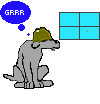
|
If he is barking out of a macho instinct to protect the house you may need to reduce his level of confidence. When this dog sees a stranger walk by, he barks. When the stranger has passed the house, the dog thinks his barking caused the stranger to leave. One solution is to get a squirt gun and fill it up with water, or even lemon juice. When the dog barks squirt him. This is even more effective if you have a friend (a stranger to the dog) squirt the dog while being barked at…and then leave only after the dog has stopped barking. Extra points if you get the dog in the mouth!!
If the dog is barking out of boredom, then make sure you are spending enough time with him, and exercising him enough. Buy him intriguing toys. Fill a hollow bone, or a “Boda ball” with peanut butter. Find ways to reduce his boredom. |

|
Separation Anxiety: This is a particularly troublesome and difficult problem. This dog is likely to bark whine, howl, and dig excessively while you are gone. He may believe that his behavior is what returned you home. If so…work on leaving him for short periods of time. Return only when he is quiet and calm. In extreme cases your dog may need an anti-anxiety medication. If this is the case, talk to your veterinarian about this option.
|

| Destructive behavior: This behavior is certainly easier to prevent than cure. Make sure you keep tempting objects out of the dog’s reach and supervise him. Crate training also helps prevent this behavior, as well as providing him with some intriguing toys of his own. If you catch him in the act of tearing up something you can use the shake can or a firm “NO.” Then take the object away and give him something appropriate for him to chew. If he has chewed up something, and you find out after the fact, there is really nothing you can do. He has likely forgotten about it. |
If you run up against any other problems that are not listed here feel free to contact me.
| Phase I: Preparing for the Puppy |
| Phase II: Training a Weimaraner |
| Phase III: Grooming a Weimaraner |
| Phase V: Coming Soon...Frequently Asked Questions |
